Non-sexual violence in Scotland: report
Findings on the most up to date, complementary statistics on non-sexual violence in Scotland.
This document is part of a collection
5 Perpetrators of violent crime
5.1 What do we know about perpetrators of violent crime?
5.1.1 Trends in the ages of perpetrators of violent crime
Key Findings:
There has been a fall in the percentage of SCJS violent incidents which involved perpetrators aged 16 to 24 from 46% in 2008-09 to 23% in 2017-18. However, findings still suggest that perpetrators of violent crime tend to be from younger age groups (under 40).
Police Recorded Crime data suggests the median age of perpetrators for several types of violence has increased since 2008-09, driven by a fall in those aged 16 to 24 years old.
Criminal Proceedings data shows the reductions in convictions for non-sexual crimes of violence and Common assault over the past ten years have been driven by a fall in those aged under 30.
Scottish Crime and Justice Survey
The SCJS found that violent crimes in 2017-18 were perpetrated by individuals from a range of age groups (Figure 10). However, only around one in every four incidents (23%) involved a perpetrator over the age of 40, suggesting perpetrators tended to be from younger cohorts[23].
Figure 10: Percentage of violent crime incidents involving offenders of each age group
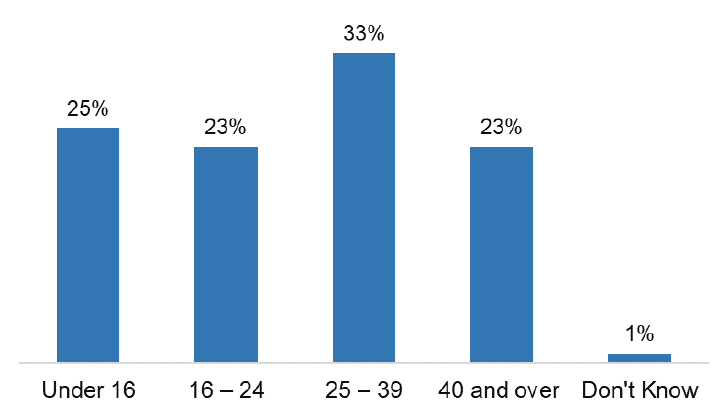
Base: Violent crime incidents where respondent could say something about offender (120); Variable: QAGE
Source: Scottish Crime and Justice Survey, 2017-18
Police Recorded Crime
Most Police Recorded Crime statistics do not include information on perpetrator age – however some findings are available from additional studies of this data (based on a review of crime records) and other statistical sources, like the Homicide National Statistics.
The median age of a Homicide perpetrator over the three years ending 2017-18 was 31 years old, compared to 26 years old for the three years ending 2008-09 (Table 18). Between those two periods the number of Homicide perpetrators fell by 49%, from 450 during the three years ending 2008-09 to 228 during the three years ending 2017-18. Most of this reduction was due to falls in the number of 16 to 24 year old perpetrators (down from 188 to 61) and to a lesser extent those aged 25 to 39 years old (down from 157 to 102 perpetrators).
Perpetrators of Attempted murder & Serious assault were also older in 2017-18 than perpetrators in 2008-09 - with their median age increasing from 23 to 27 years old. The volume of these crimes fell by 35% between those years, driven by reductions in perpetrators aged 16 to 24 years old (Table 19). For example, the estimated number of crimes with at least one perpetrator aged 16 to 24 years old fell from 2,610 in 2008-09 to 1,250 by 2017-18 (or from 40% of all perpetrators to 30%).
Despite these reductions, those aged 16 to 24 were still the most likely to commit Attempted murder & Serious assault, with an estimated 26.9 perpetrators per 10,000 population (compared to 9.8 for all ages) (Figure 11). However this rate has more than halved since 2008-09 (when it was 62.1 perpetrators per 10,000 population), with much less change in rates for the other age groups.
Figure 11: Number of perpetrators of Attempted murder & Serious assault per 10,000 population according to age of perpetrator, 2008-09 and 2017-18.
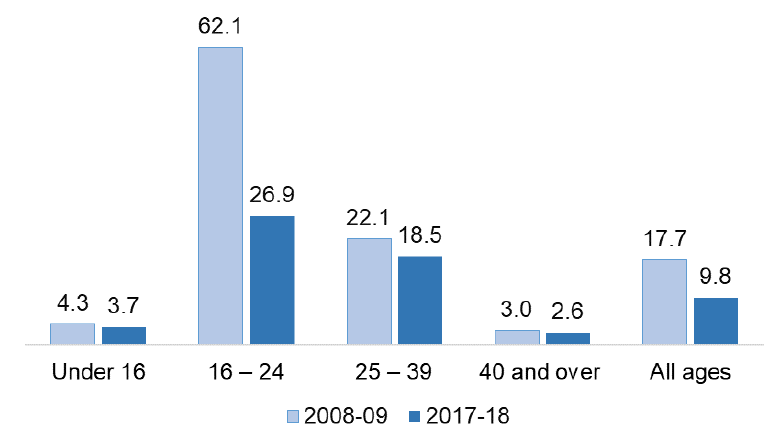
Source: Analysis of Police Recorded Crime records, 2008-09 & 2017-18
Perpetrators of Robbery were older in 2017-18 than perpetrators in 2008-09 – with their median age increasing from 23 to 28 years old. The volume of these crimes fell by 47% between those years, driven by reductions in perpetrators aged 16 to 24, and to a lesser extent those aged 25 to 39 years old (Table 20). At an estimated 10.4 perpetrators per 10,000 population in 2017-18, those aged 16 to 24 years old still remain the most likely to commit a Robbery (compared to 4.6 for all ages). However their rate is now only slightly higher than those aged 25 to 39 years old, having fallen 63% from an estimated 28.2 perpetrators per 10,000 population in 2008-09 (Figure 12).
Figure 12: Number of perpetrators of Robbery per 10,000 population according to age of perpetrator, 2008-09 and 2017-18.
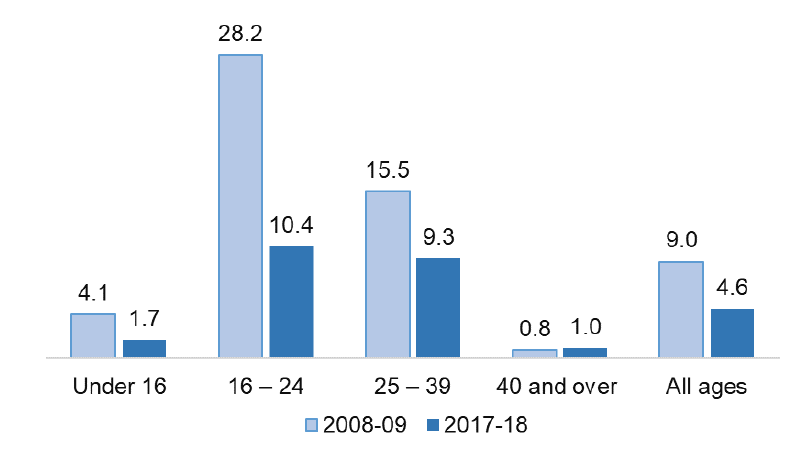
Source: Analysis of Police Recorded Crime records, 2008-09 & 2017-18
Criminal Proceedings[24]
The reduction in convictions for non-sexual crimes of violence over the past ten years has been driven by a fall in convictions for those aged under 30, most notably those aged between 18 and 25 years old (Figure 13). The median age of males convicted for these crimes increased from 23 years in 2008-09 to 28 years in 2017-18. Over the same period, the median age for females convicted increased from 26 years to 32 years.
In 2008-09, convictions of Common assault peaked at 18 years of age for males and 17 years of age for females (20.2 convictions per 1,000 population and 6 convictions per 1,000 respectively) and decreased gradually with increasing age. However, by 2017-18, both these peaks had fallen, to 7.6 convictions per 1,000 population for males, and 2 convictions per 1,000 population for females.
In 2017-18, although there was a slight variation in convictions in different year groups, the number of convictions per 1,000 population was the same for 18 year old men as it was for 30 year old men (7.6 per 1,000). For ages over 30, the conviction rate for males followed a very similar pattern to that seen in 2008-09. For females aged up to 30, there were fewer convictions per 1,000 population in 2017-18 than in 2008-09. However, for almost every age older than 30, there were slightly more convictions per 1,000 population in 2017-18 than there were in 2008-09.
Figure 13: Non-sexual crimes of violence - convictions per 1,000 population by year of age.
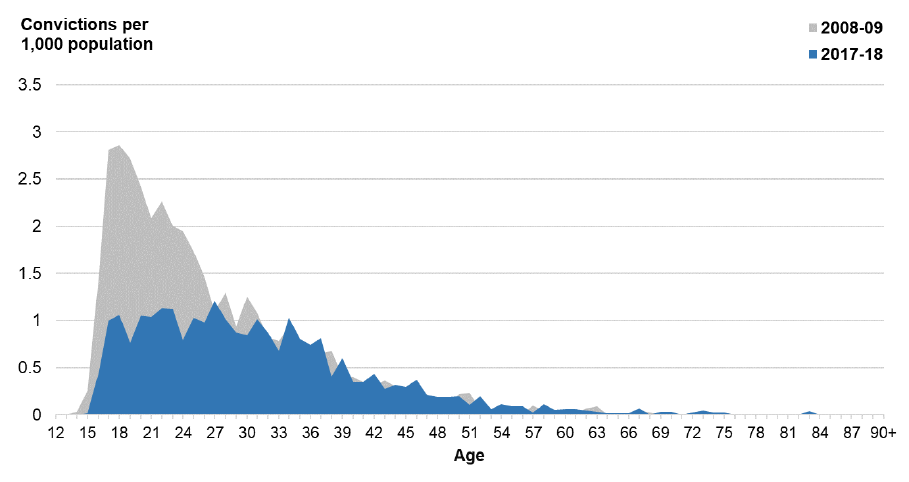
Source: Analysis of Criminal Proceedings Database, 2008-09 & 2017-18
Over the past ten years, the median age for males convicted of Common assault increased from 26 in 2008-09 to 30 in 2017-18. In 2017-18, the number of convictions for Common assault per 1,000 population was broadly the same for 18 year old males as it was for 30 year old males (7.6 per 1,000 population) (Figure 14). Thereafter, the conviction rate for males followed a very similar pattern to that seen in 2008-09.
Similarly, the median age for females convicted for Common assault increased from 26 to 31 years old between 2008-09 and 2017-18. There has been a small change in the number of females convicted of Common assault over the past decade with 0.9 convictions per 1,000 population in 2008-09 and 0.8 convictions per 1,000 population in 2017-18.
Overall, there has been a very small decrease in female convictions for Common assault in the last decade. However, this overall small decrease comprises a larger decrease in convictions for those females aged under 30 (most notably for 17 year olds) balanced by a small increase in convictions for most years from age 30 (Figure 15). This has resulted in a much wider, more even spread of ages for females convicted of Common assault.
Figure 14: Common Assault - convictions per 1,000 population by year of age (male convictions).
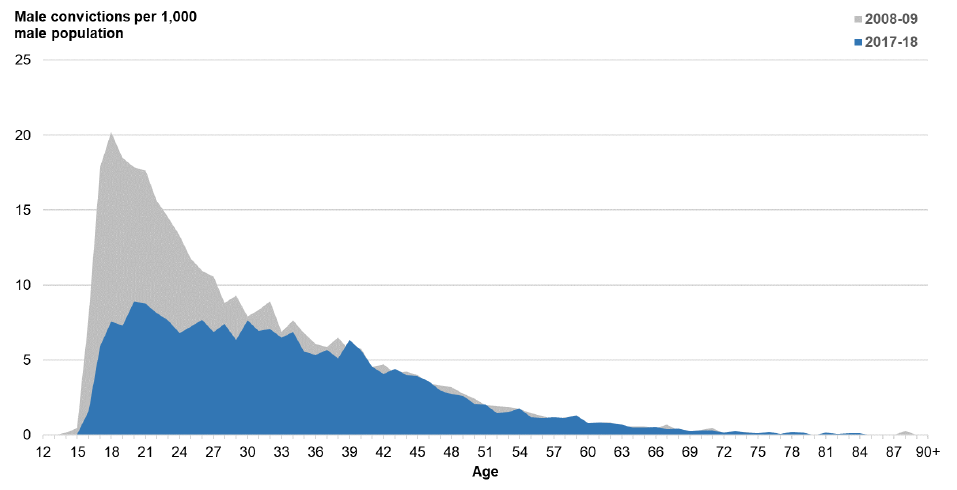
Source: Analysis of Criminal Proceedings Database, 2008-09 & 2017-18
Figure 15: Common Assault - convictions per 1,000 population by year of age (female convictions).
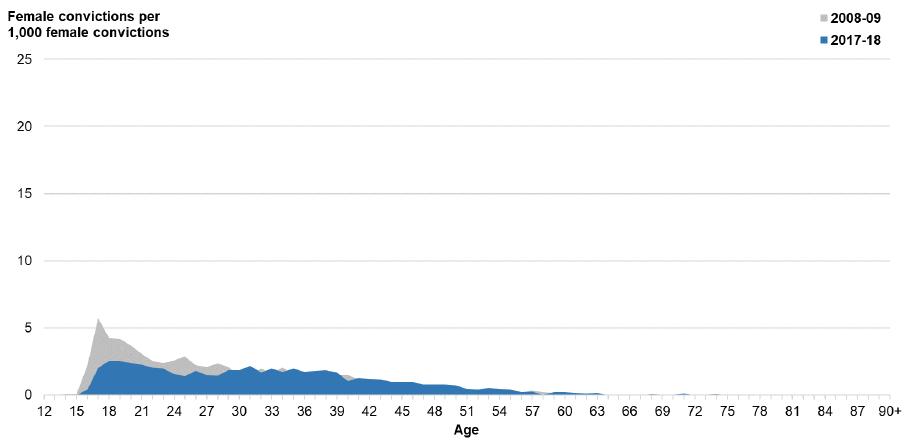
Source: Analysis of Criminal Proceedings Database, 2008-09 & 2017-18
Note: The axis in Figure 15 matches that in Figure 14 to aid comparison of volumes.
Table 18: Homicide accused by age group, 2008-09 & 2017-18.
| Age Group | 3 years ending 2008-09 | 3 years ending 2017-18 | 2008-09 to 2017-18 change | |||
|---|---|---|---|---|---|---|
| % | Total Volume | % | Total Volume | % Point Change | Total Volume Change | |
| Under 16 | 2.7% | 12 | 1.3% | 3 | ⇓ by 1.4% | -9 |
| 16 to 24 | 41.8% | 188 | 26.8% | 61 | ⇓ by 15.0% | -127 |
| 25 to 39 | 34.9% | 157 | 44.7% | 102 | ⇑ by 9.8% | -55 |
| 40+ | 20.7% | 93 | 27.2% | 62 | ⇑ by 6.5% | -31 |
| Median age of perpetrator1 | 26 years old | 31 years old | ||||
| All recorded Homicide2 | 100% | 450 | 100% | 228 | n/a | -222 |
1Three year moving average age; 2Numbers may not sum to 100% due to rounding.
Source: Homicide National Statistics, 2017-18
Table 19: Attempted murder & Serious assault perpetrators by age group, 2008-09 & 2017-18.
| Perpetrator’s Age Group | 2008-09 | 2017-18 | 2008-09 to 2017-18 change | |||
|---|---|---|---|---|---|---|
| % | Est. Volume | % | Est. Volume | % Point Change | Est. Volume Change | |
| Under 16 | 5.1% | 330 | 6.7% | 280 | No change | -50 |
| 16 to 24 | 40.4% | 2,610 | 29.9% | 1,250 | ⇓ by 10.5% | -1,360 |
| 25 to 39 | 31.3% | 2,020 | 43.4% | 1,820 | ⇑ by 12.1% | -200 |
| 40+ | 12.0% | 780 | 16.5% | 690 | No change | -90 |
| Unknown | 18.4% | 1,190 | 9.4% | 610 | ⇓ by 9.0% | -580 |
| Median age of perpetrator | 23 years old | 27 years old | ||||
| Total Attempted murder & Serious assault1,2 | 100% | 6,472 | 100% | 4,189 | n/a | -2,283 |
1 Numbers may not sum to 100% due to rounding; 2Based on a sample of crime records (550 from 2008-09 and 551 from 2017-18)
Source: Analysis of Police Recorded Crime records, 2008-09 & 2017-18.
Table 20: Robbery perpetrators by age group, 2008-09 & 2017-18.
| Perpetrator’s Age Group | 2008-09 | 2017-18 | 2008-09 to 2017-18 change | |||
|---|---|---|---|---|---|---|
| % | Est. Volume | % | Est. Volume | % Point Change | Est. Volume Change | |
| Under 16 | 7.5% | 220 | 5.4% | 80 | No change | -140 |
| 16 to 24 | 36.9% | 1,090 | 22.0% | 340 | ⇓ by 14.9% | -750 |
| 25 to 39 | 38.2% | 1,130 | 41.7% | 650 | No change | -480 |
| 40+ | 6.5% | 190 | 12.3% | 190 | by 5.8% | 0 |
| Unknown | 14.8% | 440 | 12.9% | 200 | No change | -240 |
| Median age of perpetrator | 23 years old | 28 years old | ||||
| Total Robbery1, 2 | 100% | 2,963 | 100% | 1,556 | n/a | -1,407 |
1 Numbers may not sum to 100% due to rounding; 2Based on a sample of crime records (501 from 2008-09 and 450 from 2017-18)
Source: Analysis of Police Recorded Crime records, 2008-09 & 2017-18
5.1.2 Gender of perpetrators of violent crime
Key Findings:
Across all major data sources (SCJS, Police Recorded Crime and Criminal Proceedings), the clear majority of violent crimes in 2017-18 were carried out by a male perpetrator.
The fall in levels of non-sexual violent crime since 2008-09 has been driven by fewer cases involving a male perpetrator.
Scottish Crime and Justice Survey
In 98% of violent incidents reported in the 2017-18 SCJS, respondents were able to provide some information about who committed the crime[25]. All findings are proportions of cases where respondents were able to say something about the person or people who carried out the offence, unless otherwise stated.
The SCJS results highlight that the clear majority of violent crimes in 2017-18 (78%) were carried out by male perpetrators only, which is consistent with previous years. Female perpetrators only were involved in 15% of incidents, whilst in 7% of cases both men and women were responsible.
In the self-completion section of the survey, respondents are asked if they have experienced Partner abuse, and if so are also asked the gender of the perpetrator. In 2016-18[26], of those who had experienced Partner abuse since the age of 16, 67% said the abuser was male, and 30% said the abuser was female. Less than 1% stated that both male and female partners had perpetuated abuse[27]. Breaking this down by the gender of respondents, abusive partners were overwhelmingly of the opposite gender - 97% of female respondents were abused by a male partner, and 88% of male respondents were abused by a female partner.
Police Recorded Crime
Most Police Recorded Crime statistics do not include information on perpetrator gender – however some findings are available from additional studies of this data (based on a review of crime records) and other statistical sources, like the Homicide National Statistics.
Most perpetrators of Homicide for the three years ending 2017-18 were male (89%). This has remained unchanged since the three years ending 2008-09 (Table 21). Looking at these trends over time for Homicide (Figure 16), there has been a noticeable decrease in the overall number of perpetrators, with most of this change accounted for by a fall in male perpetrators.
Figure 16: Total number of Homicide perpetrators, and Homicide perpetrators by gender, Scotland, three years ending 1996-97 to three years ending 2017-18.
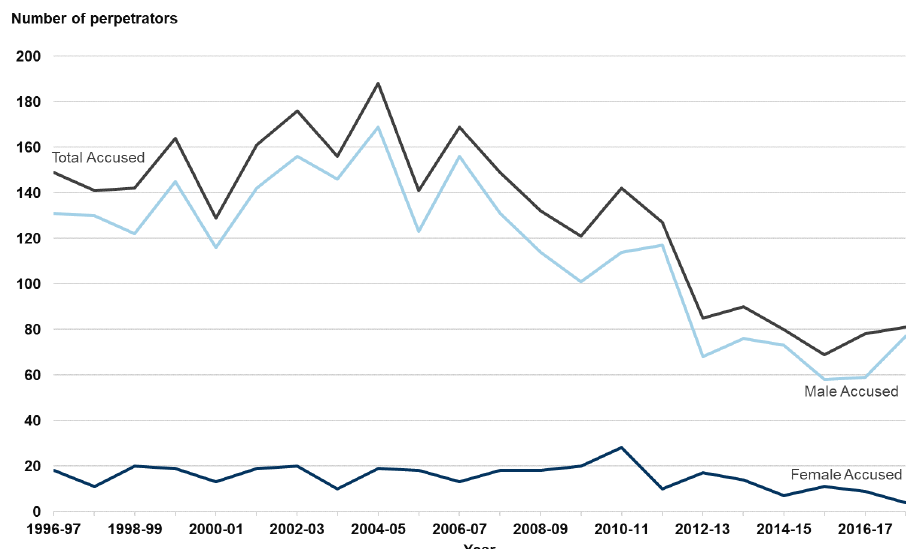
Source: Homicide National Statistics, 2017-18
The clear majority (84%) of Attempted murder & Serious assaults had a male or all male group of perpetrators in 2017-18 (Table 22). This is similar to the figure in 2008-09 (82%). In 2017-18, only 10% had a female or all female group of perpetrators, whilst the remaining 6% had a mixed gender group or a perpetrator of unknown gender. Attempted murder & Serious assault with a male or all male group of perpetrators is estimated to have fallen by 1,810 between 2008-09 and 2017-18, from 5,330 to 3,520. This fall accounts for the clear majority (around 80%) of the total reduction in these crimes since 2008-09.
Around five out of every six Robberies (82%) had a male or all male group of perpetrators in 2017-18 (Table 23). This has fallen from 88% in 2008-09. Only 6% of Robberies in 2017-18 had a female or all female group of perpetrators, whilst the remaining 12% had a mixed gender group or a perpetrator of unknown gender. Robbery with a male or all male group of perpetrators is estimated to have fallen by 1,340 between 2008-09 and 2017-18, from 2,610 to 1,270. This fall accounts for almost all of the total reduction in Police Recorded Robbery between those two years.
An earlier study into Common assault[28] recorded by the police in 2014-15 found that around three quarters (74%) of perpetrators were male. Around a quarter (24%) of were female while the remaining 2% were mixed gender groups or unknown.
Criminal Proceedings
A separate analysis was conducted on the profile of people convicted of non-sexual crimes of violence and Common assault, based on data from the Criminal Proceedings database[29]. This showed that the vast majority of these crimes were carried out by a male perpetrator. Between 2008-09 and 2017-18, males accounted for between 87% and 88% of all convicted.
Further to this, the number of Common Assault convictions per 1,000 population for men has fallen in the past decade, from 4.5 per 1,000 population in 2008-09 to 2.9 per 1,000 population in 2017-18. Over the same period, the number of female convictions for Common Assault remained relatively unchanged (dropping from 0.9 convictions per 1,000 population in 2008-09 to 0.8 in 2017-18).
Table 21: All recorded Homicide perpetrators by gender, three years ending 2008-09 & 2017-18.
| Perpetrator’s Gender | 3 years ending 2008-09 |
3 years ending 2017-18 |
2008-09 to 2017-18 change | |||
|---|---|---|---|---|---|---|
| % | Volume | % | Volume | % Point Change | Volume Change | |
| Male | 89% | 401 | 89% | 204 | <1% | -197 |
| Female | 11% | 49 | 11% | 24 | <1% | -25 |
| All recorded Homicide where known1 | 100% | 450 | 100% | 228 | n/a | -222 |
1 Numbers may not sum to 100% due to rounding
Source: Homicide National Statistics, 2017-18
Table 22: Attempted murder & Serious assault perpetrators by gender, 2008-09 & 2017-18.
| Perpetrator’s Gender | 2008-09 | 2017-18 | 2008-09 to 2017-18 change | |||
|---|---|---|---|---|---|---|
| % | Est. Volume | % | Est. Volume | % Point Change | Est. Volume Change | |
| Male / All male | 82% | 5,330 | 84% | 3,520 | No Change | -1,810 |
| Female / All female | 8% | 490 | 10% | 410 | No Change | -80 |
| Mixed Group / Other / Unknown | 10% | 650 | 6% | 260 | No Change | -390 |
| Total Attempted murder & Serious assault1,2 | 100% | 6,472 | 100% | 4,189 | n/a | -2,283 |
1 Numbers may not sum to 100% due to rounding; 2Based on a sample of crime records (550 from 2008-09 and 551 from 2017-18)
Source: Analysis of Police Recorded Crime records, 2008-09 & 2017-18.
Table 23: Robbery perpetrators by gender, 2008-09 & 2017-18.
| Perpetrator’s Gender | 2008-09 | 2017-18 | 2008-09 to 2017-18 change | |||
|---|---|---|---|---|---|---|
| % | Est. Volume | % | Est. Volume | % Point Change | Est. Volume Change | |
| Male / All male group | 88% | 2,610 | 82% | 1,270 | ⇓ by 6% | -1,340 |
| Female / All female group | 4% | 120 | 6% | 100 | No Change | -20 |
| Mixed Group / Other / Unknown | 8% | 230 | 12% | 180 | No Change | -50 |
| Total Robbery1,2 | 100% | 2,963 | 100% | 1,556 | n/a | -1,407 |
1 Numbers may not sum to 100% due to rounding; 2Based on a sample of crime records (501 from 2008-09 and 450 from 2017-18)
Source: Analysis of Police Recorded Crime records, 2008-09 & 2017-18
5.2 The relationship between victims and perpetrators of violent crime
Key Findings:
Both the SCJS and Police Recorded Crime data suggest that, in general, perpetrators of violent crime are known to the victim. The exception to this is Robbery, most of which is committed by someone not known to the victim.
While the majority of Homicide victims are killed by someone known to them, males are more likely to be killed by an acquaintance whereas females are more likely to be killed by a partner or ex-partner.
Females are more likely to be the victim of Attempted murder & Serious assault, and Common assault committed by a partner or ex-partner.
Over the past ten years, almost all of the reduction in Robbery has been driven by fewer crimes committed by strangers.
Scottish Crime and Justice Survey
The SCJS found that in 2017-18, most violent incidents (74%) were committed by people who the victims knew or had seen before. Where perpetrators where known by the victim, more than two-thirds of incidents (68%) were said to have involved people ‘known well’.
Police Recorded Crime
Most Police Recorded Crime statistics do not include information on the relationship between the victim and perpetrator – however some findings are available from additional studies of this data (based on a review of crime records) and other statistical sources, like the Homicide National Statistics.
Where a violent crime is recorded by the police, in general, the perpetrator was known to the victim. For example, in 2017-18, 68% of Homicide victims over the three years ending 2017-18 knew the perpetrator, as too did 66% of Attempted murder & Serious assault victims. An earlier 2014-15 study of Common Assault found that around three-fifths (61%) of cases involved a victim who knew the perpetrator. One type of non-sexual violent crime with a different pattern is Robbery, where the majority of cases in 2017-18 (63%) involved a perpetrator not known to the victim.
Looking at Homicide over the longer term, again the majority of victims were killed by someone they knew (Table 24) including 76% of those killed between 2008-09 and 2017-18. Of all Homicide victims in the last ten years, half (51%) were killed by an acquaintance, 15% by a partner or ex-partner and around one in ten (11%) by a relative. Males were more likely to be killed by an acquaintance (59%) compared with females (27%), whereas females were more likely to be killed by a partner or ex-partner (43%) compared to males (5%).
Females are more likely to be the victim of Attempted murder & Serious assault by a partner or ex-partner than males. In 2017-18, 44% of Attempted murder & Serious assault with a female victim was committed by a partner or ex-partner, compared to 3% of Attempted murder & Serious assault with a male victim.
Similarly, females are more likely to be the victim of a Common assault committed by a partner or ex-partner than males. In 2014-15, 46% of Common assault with a female victim involved a partner or ex-partner as perpetrator, compared to 14% of Common assault with a male victim.
Over the past ten years the number of victims of Homicide fell by over two-fifths (46% or 150 victims) from 327 for the three years ending 2008-09 to 177 for the three years ending 2017-18. This reduction has been driven, in part, by Homicides where the victim knew the perpetrator.
Almost all of the reduction over the past ten years in Robbery has been driven by fewer crimes committed by strangers (Table 25). For example there were an estimated 2,240 Robberies where the victim did not know the perpetrator in 2008-09, falling by 1,250 crimes to 990 by 2017-18. At the same time there was no change between 2008-09 and 2017-18 in the estimated volume of Robberies where the victim knew the perpetrator.
Changes in the relationship profile of victims / perpetrators for Attempted murder & Serious assault should be treated with more caution as the proportion of cases with an ‘unknown’ relationship fell from 21% in 2008-09 to 12% in 2017-18 (Table 26). Over the past ten years the number of crimes of Attempted murder & Serious assault where the perpetrator was not known to the victim fell by an estimated 800 cases from 1,710 in 2008-09 to 910 in 2017-18. Whereas, crimes where the victim did know the perpetrator fell by an estimated 610 crimes from 3,380 in 2008-09 to 2,770 in 2017-18.
Table 24: Relationship of main Homicide perpetrator to victim for all victims between 2008-09 to 2017-18.
| Relationship | Male victims | Female victims | All victims | |||
|---|---|---|---|---|---|---|
| % | Volume | % | Volume | % | Volume | |
| Known to | 73% | 398 | 86% | 157 | 76% | 555 |
| Acquaintances | 59% | 321 | 27% | 49 | 51% | 370 |
| Partner / ex-partner | 5% | 29 | 43% | 78 | 15% | 107 |
| Relatives | 9% | 58 | 16% | 30 | 11% | 78 |
| Strangers | 21% | 117 | 9% | 17 | 18% | 134 |
| Unknown | 6% | 31 | 4% | 8 | 5% | 39 |
| All recorded Homicide victims1,2 | 100% | 546 | 100% | 182 | 100% | 728 |
1 Numbers may not sum to 100% due to rounding; 2 For all Homicides where a perpetrator has been identified.
Source: Homicide National Statistics, 2017-18
Table 25: Relationship between Robbery victims and perpetrators, 2008-09 & 2017-18.
| Relationship | 2008-09 | 2017-18 | 2008-09 to 2017-18 change | |||
|---|---|---|---|---|---|---|
| % | Est. Volume | % | Est. Volume | % Point Change | Est. Volume Change | |
| Robbery | ||||||
| Known to victim | 18% | 530 | 34% | 530 | ⇓ by 16% | No Change |
| Not known to victim | 76% | 2,240 | 63% | 990 | ⇑ by 12% | -1,250 |
| Unknown | 7% | 200 | 2% | 40 | No Change | -160 |
| Total Robbery1,2 | 100% | 2,963 | 100% | 1,556 | n/a | -1,407 |
1 Numbers may not sum to 100% due to rounding; 2 Based on a sample of crime records (501 from 2008-09 and 450 from 2017-18)
Source: Analysis of Police Recorded Crime records, 2008-09 & 2017-18.
Table 26: Relationship between Attempted murder & Serious assault victims and perpetrators, 2008-09 & 2017-18.
| Relationship | 2008-09 | 2017-18 | 2008-09 to 2017-18 change | |||
|---|---|---|---|---|---|---|
| % | Est. Volume | % | Est. Volume | % Point Change | Est. Volume Change | |
| Attempted murder & Serious assault | ||||||
| Known to victim | 52% | 3,380 | 66% | 2,770 | ⇓ by 14% | -610 |
| Not known to victim | 26% | 1,710 | 22% | 910 | No Change | -800 |
| Unknown | 21% | 1.390 | 12% | 500 | ⇑ by 9% | -890 |
| All recorded Attempted murder & Serious assault1,2 | 100% | 6,472 | 100% | 4,189 | n/a | -2,283 |
1 Numbers may not sum to 100% due to rounding; from 2017-18) ; 2 Based on a sample of crime records (550 from 2008-09 and 551 from 2017-18)
Source: Analysis of Police Recorded Crime records, 2008-09 & 2017-18.
Contact
Email: Frances.warren@gov.scot
There is a problem
Thanks for your feedback